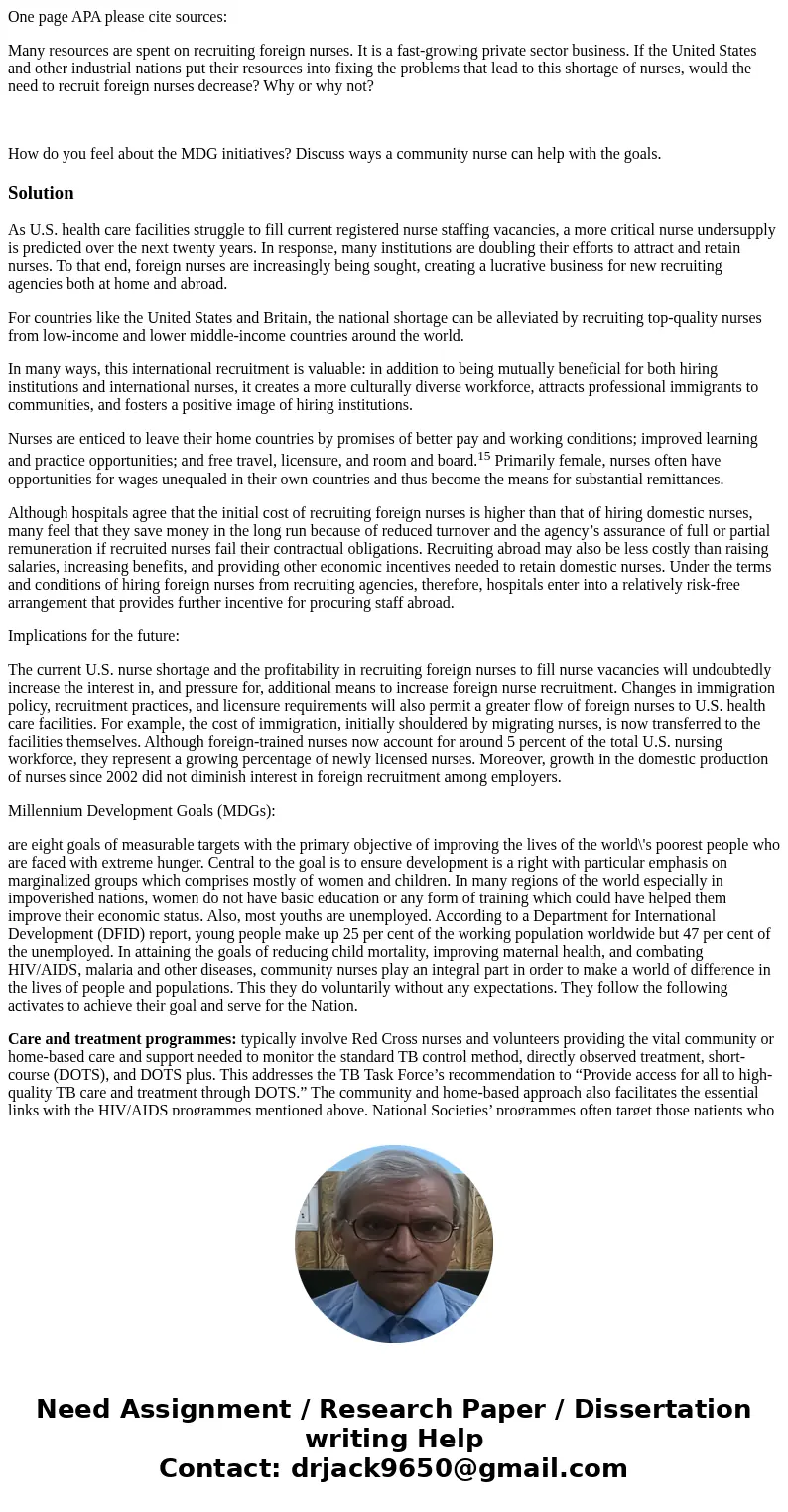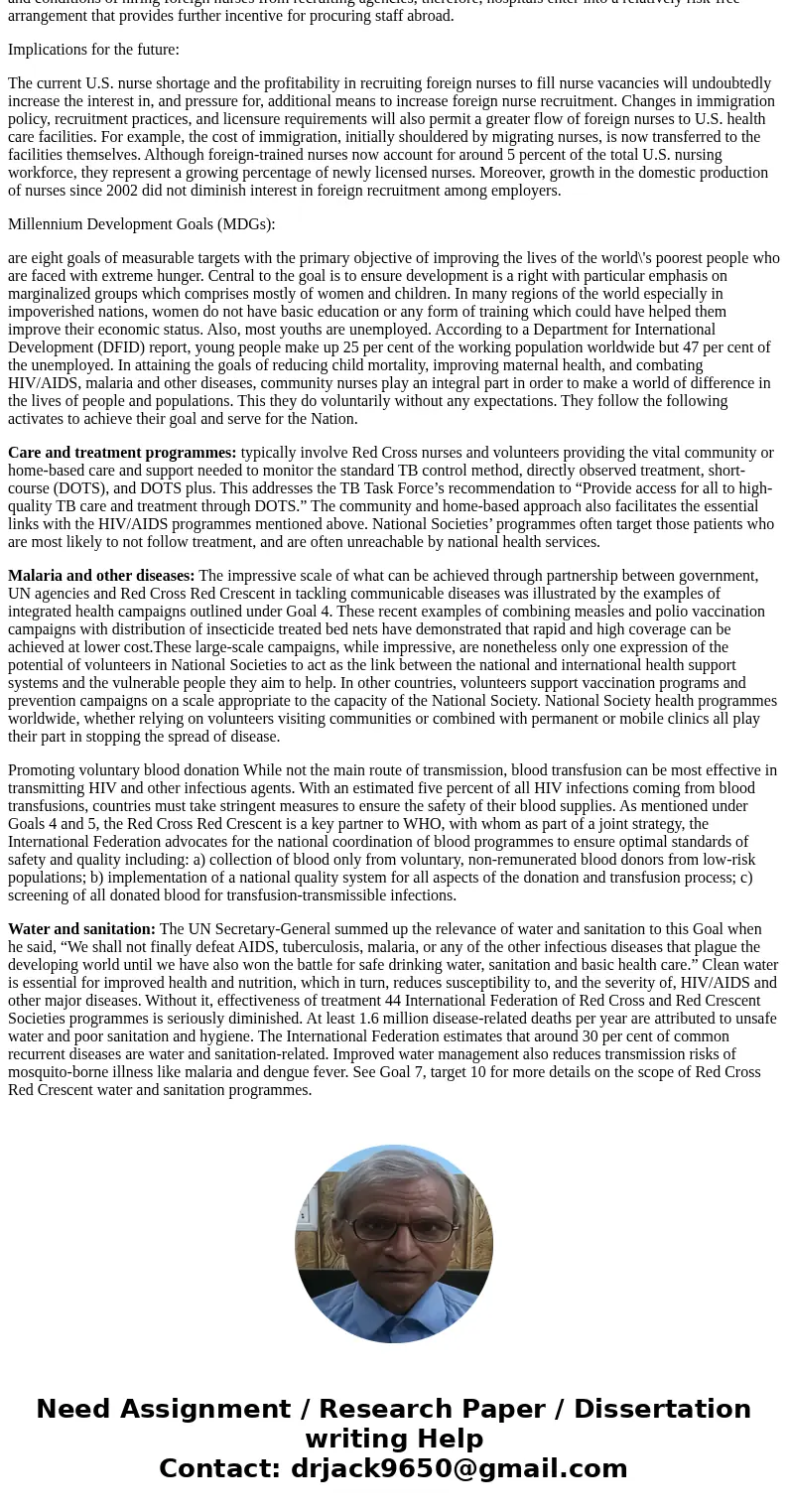One page APA please cite sources Many resources are spent on
One page APA please cite sources:
Many resources are spent on recruiting foreign nurses. It is a fast-growing private sector business. If the United States and other industrial nations put their resources into fixing the problems that lead to this shortage of nurses, would the need to recruit foreign nurses decrease? Why or why not?
How do you feel about the MDG initiatives? Discuss ways a community nurse can help with the goals.
Solution
As U.S. health care facilities struggle to fill current registered nurse staffing vacancies, a more critical nurse undersupply is predicted over the next twenty years. In response, many institutions are doubling their efforts to attract and retain nurses. To that end, foreign nurses are increasingly being sought, creating a lucrative business for new recruiting agencies both at home and abroad.
For countries like the United States and Britain, the national shortage can be alleviated by recruiting top-quality nurses from low-income and lower middle-income countries around the world.
In many ways, this international recruitment is valuable: in addition to being mutually beneficial for both hiring institutions and international nurses, it creates a more culturally diverse workforce, attracts professional immigrants to communities, and fosters a positive image of hiring institutions.
Nurses are enticed to leave their home countries by promises of better pay and working conditions; improved learning and practice opportunities; and free travel, licensure, and room and board.15 Primarily female, nurses often have opportunities for wages unequaled in their own countries and thus become the means for substantial remittances.
Although hospitals agree that the initial cost of recruiting foreign nurses is higher than that of hiring domestic nurses, many feel that they save money in the long run because of reduced turnover and the agency’s assurance of full or partial remuneration if recruited nurses fail their contractual obligations. Recruiting abroad may also be less costly than raising salaries, increasing benefits, and providing other economic incentives needed to retain domestic nurses. Under the terms and conditions of hiring foreign nurses from recruiting agencies, therefore, hospitals enter into a relatively risk-free arrangement that provides further incentive for procuring staff abroad.
Implications for the future:
The current U.S. nurse shortage and the profitability in recruiting foreign nurses to fill nurse vacancies will undoubtedly increase the interest in, and pressure for, additional means to increase foreign nurse recruitment. Changes in immigration policy, recruitment practices, and licensure requirements will also permit a greater flow of foreign nurses to U.S. health care facilities. For example, the cost of immigration, initially shouldered by migrating nurses, is now transferred to the facilities themselves. Although foreign-trained nurses now account for around 5 percent of the total U.S. nursing workforce, they represent a growing percentage of newly licensed nurses. Moreover, growth in the domestic production of nurses since 2002 did not diminish interest in foreign recruitment among employers.
Millennium Development Goals (MDGs):
are eight goals of measurable targets with the primary objective of improving the lives of the world\'s poorest people who are faced with extreme hunger. Central to the goal is to ensure development is a right with particular emphasis on marginalized groups which comprises mostly of women and children. In many regions of the world especially in impoverished nations, women do not have basic education or any form of training which could have helped them improve their economic status. Also, most youths are unemployed. According to a Department for International Development (DFID) report, young people make up 25 per cent of the working population worldwide but 47 per cent of the unemployed. In attaining the goals of reducing child mortality, improving maternal health, and combating HIV/AIDS, malaria and other diseases, community nurses play an integral part in order to make a world of difference in the lives of people and populations. This they do voluntarily without any expectations. They follow the following activates to achieve their goal and serve for the Nation.
Care and treatment programmes: typically involve Red Cross nurses and volunteers providing the vital community or home-based care and support needed to monitor the standard TB control method, directly observed treatment, short-course (DOTS), and DOTS plus. This addresses the TB Task Force’s recommendation to “Provide access for all to high-quality TB care and treatment through DOTS.” The community and home-based approach also facilitates the essential links with the HIV/AIDS programmes mentioned above. National Societies’ programmes often target those patients who are most likely to not follow treatment, and are often unreachable by national health services.
Malaria and other diseases: The impressive scale of what can be achieved through partnership between government, UN agencies and Red Cross Red Crescent in tackling communicable diseases was illustrated by the examples of integrated health campaigns outlined under Goal 4. These recent examples of combining measles and polio vaccination campaigns with distribution of insecticide treated bed nets have demonstrated that rapid and high coverage can be achieved at lower cost.These large-scale campaigns, while impressive, are nonetheless only one expression of the potential of volunteers in National Societies to act as the link between the national and international health support systems and the vulnerable people they aim to help. In other countries, volunteers support vaccination programs and prevention campaigns on a scale appropriate to the capacity of the National Society. National Society health programmes worldwide, whether relying on volunteers visiting communities or combined with permanent or mobile clinics all play their part in stopping the spread of disease.
Promoting voluntary blood donation While not the main route of transmission, blood transfusion can be most effective in transmitting HIV and other infectious agents. With an estimated five percent of all HIV infections coming from blood transfusions, countries must take stringent measures to ensure the safety of their blood supplies. As mentioned under Goals 4 and 5, the Red Cross Red Crescent is a key partner to WHO, with whom as part of a joint strategy, the International Federation advocates for the national coordination of blood programmes to ensure optimal standards of safety and quality including: a) collection of blood only from voluntary, non-remunerated blood donors from low-risk populations; b) implementation of a national quality system for all aspects of the donation and transfusion process; c) screening of all donated blood for transfusion-transmissible infections.
Water and sanitation: The UN Secretary-General summed up the relevance of water and sanitation to this Goal when he said, “We shall not finally defeat AIDS, tuberculosis, malaria, or any of the other infectious diseases that plague the developing world until we have also won the battle for safe drinking water, sanitation and basic health care.” Clean water is essential for improved health and nutrition, which in turn, reduces susceptibility to, and the severity of, HIV/AIDS and other major diseases. Without it, effectiveness of treatment 44 International Federation of Red Cross and Red Crescent Societies programmes is seriously diminished. At least 1.6 million disease-related deaths per year are attributed to unsafe water and poor sanitation and hygiene. The International Federation estimates that around 30 per cent of common recurrent diseases are water and sanitation-related. Improved water management also reduces transmission risks of mosquito-borne illness like malaria and dengue fever. See Goal 7, target 10 for more details on the scope of Red Cross Red Crescent water and sanitation programmes.


 Homework Sourse
Homework Sourse